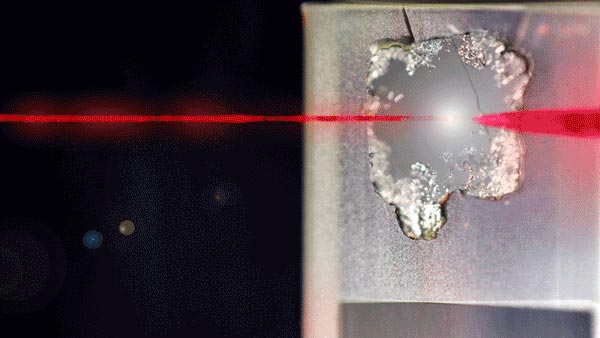Ultra-fast laser spectroscopy lights way to understanding new materials

Ames Laboratory scientists use ultra-fast laser spectroscopy to "see" tiny actions in real time in materials. Scientists apply a pulse laser to a sample to excite the material. Some of the laser light is absorbed by the material, but the light that passes through or reflected from the material can be used to take super-fast “snapshots” of what is going on in the material following the laser pulse.
Physicist Jigang Wang and his colleagues recently used ultra-fast laser spectroscopy to examine and explain the mysterious electronic properties of iron-based superconductors. Results appeared in Nature Communications this month.
Superconductors are materials that, when cooled below a certain temperature, display zero electrical resistance, a property that could someday make possible lossless electrical distribution. Superconductors start in a “normal” often magnetic state and then transition to a superconducting state when they are cooled to a certain temperature.
What is still a mystery is what goes on in materials as they transform from normal to superconducting. And this “messy middle” area of superconducting materials’ behavior holds richer information about the why and how of superconductivity than do the stable areas.
“The stable states of materials aren’t quite as interesting as the crossover region when comes to understanding materials’ mechanisms because everything is settled and there’s not a lot of action. But, in this crossover region to superconductivity, we can study the dynamics, see what goes where and when, and this information will tell us a lot about the interplay between superconductivity and magnetism,” said Wang, who is also an associate professor of physics and astronomy at Iowa State University.
But the challenges is that in the crossover region, all the different sets of materials properties that scientists examine, like its magnetic order and electronic order, are all coupled. In other words, when there’s a change to one set of properties, it changes all the others. So, it’s really difficult to trace what individual changes and properties are dominant.
The complexity of this coupled state has been studied by groundbreaking work by research groups at Ames Laboratory over the past five years. Paul Canfield, an Ames Laboratory scientist and expert in designing and developing iron-based superconductor materials, created and characterized a very high quality single crystal used in this investigation. These high-quality single crystals had been exceptionally well characterized by other techniques and were essentially “waiting for their close up” under Wang's ultra-fast spot-light.
Wang and the team used ultra-fast laser spectroscopy to “see” the tiny actions in materials. In ultra-fast laser spectroscopy, scientists apply a pulsed laser to a materials sample to excite particles within the sample. Some of the laser light is absorbed by the material, but the light that passes through the material can be used to take super-fast “snapshots” of what is going on in the material following the laser pulse and then replayed afterward like a stop-action movie.
The technique is especially well suited to understanding the crossover region of iron-arsenide based superconductors materials because the laser excitation alters the material so that different properties of the material are distinguishable from each other in time, even the most subtle evolutions in the materials’ properties.
“Ultra-fast laser spectroscopy is a new experimental tool to study dynamic, emergent behavior in complex materials such as these iron-based superconductors,” said Wang. Specifically, we answered the pressing question of whether an electronically-driven nematic order exists as an independent phase in iron-based superconductors, as these materials go from a magnetic normal state to superconducting state. The answer is yes. This is important to our overall understanding of how superconductors emerge in this type of materials.”
Aaron Patz and Tianqi Li collaborated on the laser spectroscopy work. Sheng Ran, Sergey L. Bud’ko and Paul Canfield collaborated on sample development at Ames Laboratory and Iowa State University. Rafael M. Fernandes at the University of Minnesota, Joerg Schmalian, formerly of Ames Laboratory and now at Karlsruhe Institute of Technology and Ilias E. Perakis at University of Crete, Greece collaborated on the simulation work.
Wang, Patz, Li, Ran, Bud’ko and Canfield’s work at Ames Laboratory was supported by the U.S. Department of Energy's Office of Science, (sample preparation and characterization). Wang's work on pnictide superconductors is supported by Ames Laboratory’s Laboratory Directed Research and Development (LDRD) funding (femtosecond laser spectroscopy).
DOE’s Office of Science is the single largest supporter of basic research in the physical sciences in the United States, and is working to address some of the most pressing challenges of our time. For more information, please visit the Office of Science website at science.energy.gov/.
Ames Laboratory is a U.S. Department of Energy Office of Science national laboratory operated by Iowa State University. Ames Laboratory creates innovative materials, technologies and energy solutions. We use our expertise, unique capabilities and interdisciplinary collaborations to solve global problems.
Contacts:
Jigang Wang, Material Sciences and Engineering, 515-294-5630
Breehan Gerleman Lucchesi, Public Affairs, 515-294-9750
Media Contact
All latest news from the category: Materials Sciences
Materials management deals with the research, development, manufacturing and processing of raw and industrial materials. Key aspects here are biological and medical issues, which play an increasingly important role in this field.
innovations-report offers in-depth articles related to the development and application of materials and the structure and properties of new materials.
Newest articles

Sensors for the “charge” of biological cells
A team led by plant biotechnologist Prof Markus Schwarzländer from the University of Münster and biochemist Prof Bruce Morgan from Saarland University has developed new biosensors with which the ratio…

New scan method unveils lung function secrets
A new method of scanning lungs is able to show the effects of treatment on lung function in real time and enable experts to see the functioning of transplanted lungs….

Grapes of math: Quantum breakthrough bears fruit
Grapes show promise for quantum sensing breakthrough. Macquarie University researchers have demonstrated how ordinary supermarket grapes can enhance the performance of quantum sensors, potentially leading to more efficient quantum technologies….



